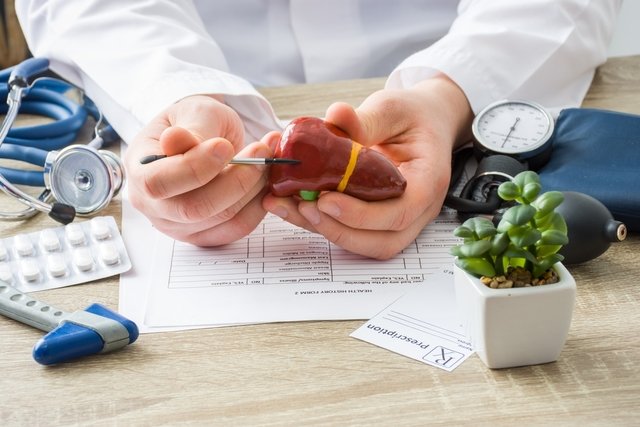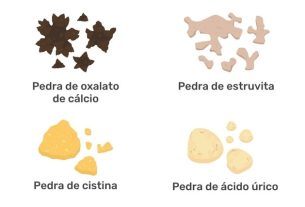Fatty liver is usually caused by unhealthy lifestyle habits, such as a diet rich in fat and carbohydrates, a sedentary lifestyle and excessive alcohol consumption. However, fatty liver can also be caused by medication use, diabetes, hepatitis B or C, malnutrition and Wilson’s disease.
Fat in the liver, also called hepatic steatosis, normally does not cause symptoms and is identified during routine exams. However, as the disease progresses, symptoms such as loss of appetite, abdominal pain, belly swelling, yellowing of the skin and eyes, and whitish stools may appear. Know how to recognize the symptoms of fatty liver.
In the presence of signs and symptoms possibly indicative of fatty liver, it is important that a hepatologist or general practitioner is consulted so that the diagnosis can be made and the most appropriate treatment can be initiated, with improvements in eating habits and lifestyle being normally recommended.

Main causes
The main causes of fatty liver are:
1. Obesity, diabetes and insulin resistance
Obesity, type 2 diabetes and insulin resistance are the most frequently associated diseases that help with the accumulation of fat in the liver. In these cases, there is an imbalance between the production and use of triglycerides by the body, which causes an increase in fat stored in the liver.
What to do: It is important that the doctor’s recommendations are followed to reduce circulating blood glucose levels, it is important to have a healthy and balanced diet and practice physical activity regularly. This way it is possible to reduce weight, promote fat burning and regulate glucose levels.
2. High cholesterol or triglycerides
High cholesterol is one of the main causes of fatty liver, especially when there is an increase in triglyceride levels and a decrease in HDL, the good cholesterol.
What to do: It is recommended to reduce the consumption of foods rich in fat, giving preference to foods rich in fiber, fruits and vegetables. Thus, it is possible to reduce the risk of fat deposition in the liver, in addition to preventing the development of cardiovascular diseases. See what to eat to lower cholesterol.
3. Food rich in fat and sugar
The accumulation of fat in the liver is also related to lifestyle. The combination of eating foods rich in sugar, fat and low in fiber along with a sedentary lifestyle results in weight gain, worsening liver steatosis.
What to do: In this case, it is important to improve eating habits, reducing the consumption of processed foods, rich in fat and sugar, and giving preference to foods rich in fiber, fruits and vegetables. Furthermore, it is important to practice physical activity on a regular basis, as this makes it possible to use the fat stored in the body and circulating sugar as a source of energy, reducing the accumulation of fat in the liver.
4. Excessive alcohol consumption
Fatty liver can also appear when there is excessive alcohol consumption, and this excess is considered when the daily amount of alcohol is more than 20 g for women and more than 30 g for men, which is equivalent to 2 or 3 drinks , respectively.
What to do: It is recommended to reduce the consumption of alcoholic beverages, as this makes it possible to reduce liver inflammation and accumulated fat, relieving symptoms and promoting improvement.
5. Hepatitis B or C
People who have chronic hepatitis B or hepatitis C are more likely to have fatty liver and other related diseases because the presence of lesions caused by hepatitis in the liver cells make it difficult for the organ to work, facilitating the accumulation of fat.
What to do: It is important to follow the recommendations indicated by your doctor for treating hepatitis, which may involve the use of medication, rest, hydration, reducing the consumption of alcoholic beverages and a light, healthy diet.
6. Use of medications
The use of medications such as amiodarone, corticosteroids, estrogens or tamoxifen, for example, contribute to the accumulation of fat in the liver. This is because the use of these medications can cause damage to the liver and, as a consequence, hepatic steatosis.
What to do: In these cases, it is important that an assessment be carried out by the doctor who indicated the use of the medication, as this will allow an assessment to be made regarding the possibility of suspending or changing the medication.
7. Wilson’s disease
Wilson’s disease is a rare disease that manifests itself in childhood. It is characterized by the body’s inability to metabolize excess copper in the body, resulting in intoxication. This excess copper is normally stored in the liver, which will cause damage to the cell and facilitate the accumulation of fat in the organ. Learn more about Wilson’s disease and treatment.
What to do: It is important that the general practitioner is consulted so that copper levels in the blood can be checked and the most appropriate treatment can be indicated. In general, the doctor recommends the use of medications that bind to copper and promote its elimination through the intestine and kidneys. Furthermore, it is recommended to reduce the consumption of foods that are sources of copper, such as dried fruits, mushrooms and nuts, for example.
8. Malnutrition
Malnutrition causes a decrease in lipoproteins in the body, which are the molecules responsible for removing fat. The lack of these lipoproteins makes it impossible for triglycerides to leave the liver, which end up accumulating in the organ, causing a fatty liver.
What to do: It is recommended that a nutritionist be consulted so that treatment can be started, which consists of gradually increasing the amount of calories consumed during the day, and in some cases, the use of dietary supplements may also be indicated. Understand better how malnutrition is treated.
How to confirm
Excess fat in the liver usually has no signs or symptoms, and is usually diagnosed by chance when a person undergoes an ultrasound of the abdomen as part of their routine exams. After suspicion, the doctor evaluates the levels of TGO and TGP liver enzymes, in addition to the concentration of bilirubin, cholesterol and gamma-GT in the blood to confirm the disease.
In more serious cases, which is when hepatic steatosis is not identified and treated in its early stages, there may be symptoms such as poor digestion, frequent tiredness, loss of appetite and a swollen belly, for example. Check out the main symptoms of hepatic steatosis.
Complications of excess fat in the liver
Complications from fat accumulation in the liver depend on the patient’s lifestyle and associated factors, such as diabetes, obesity or immune diseases. But, generally, there is progressive inflammation of the liver that can lead to the emergence of serious diseases, such as liver cirrhosis. Know how to recognize the symptoms of liver cirrhosis.
To avoid the consequences of fat accumulation in the liver, it is recommended that people follow a diet rich in fruits and vegetables, avoiding eating foods with a lot of fat and sugar. In addition, you should also exercise regularly, at least 30 minutes a day.

Sign up for our newsletter and stay up to date with exclusive news
that can transform your routine!
Warning: Undefined array key "title" in /home/storelat/public_html/wp-content/plugins/link-whisper-premium/templates/frontend/related-posts.php on line 12
Warning: Undefined array key "title_tag" in /home/storelat/public_html/wp-content/plugins/link-whisper-premium/templates/frontend/related-posts.php on line 13



